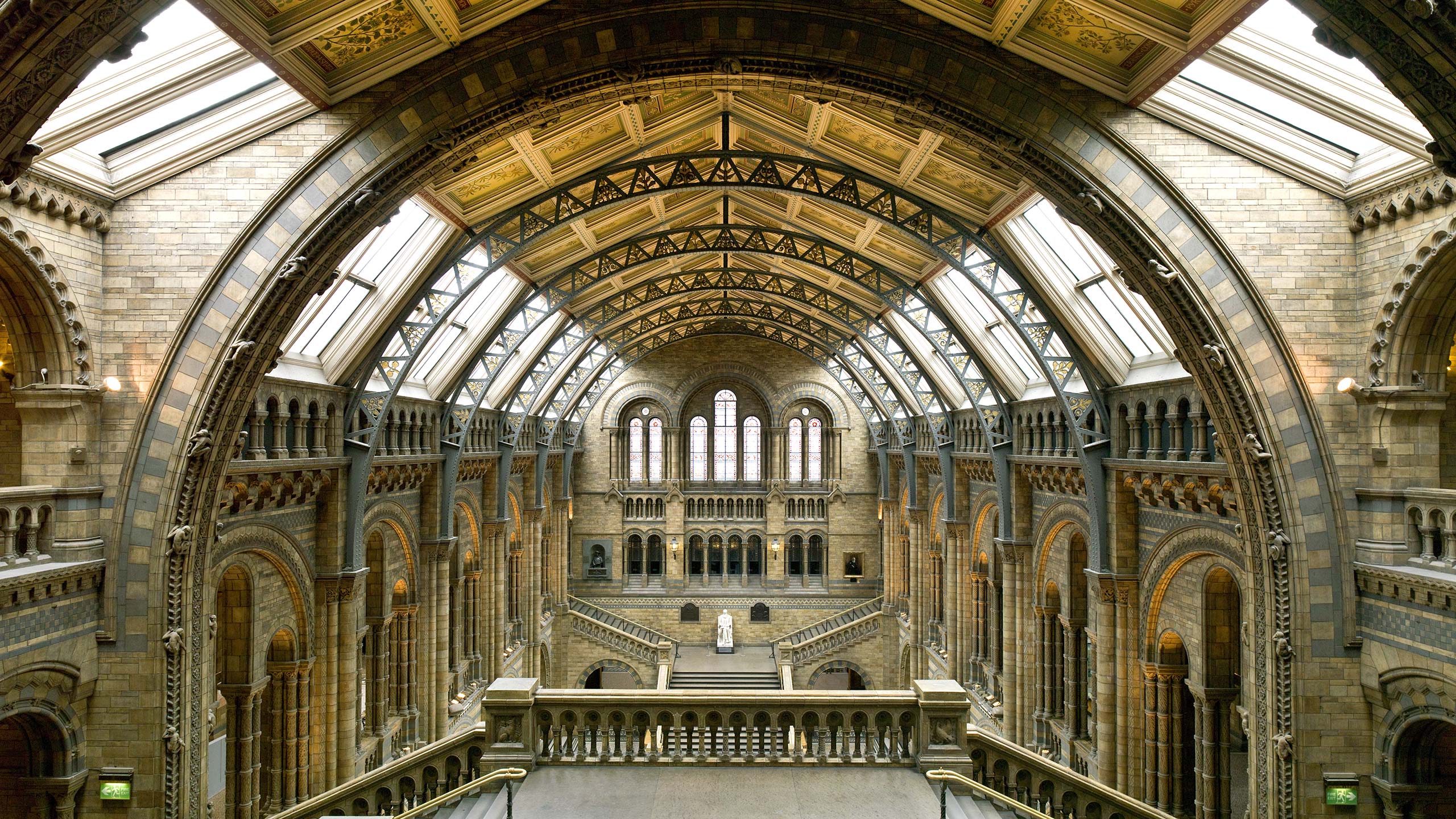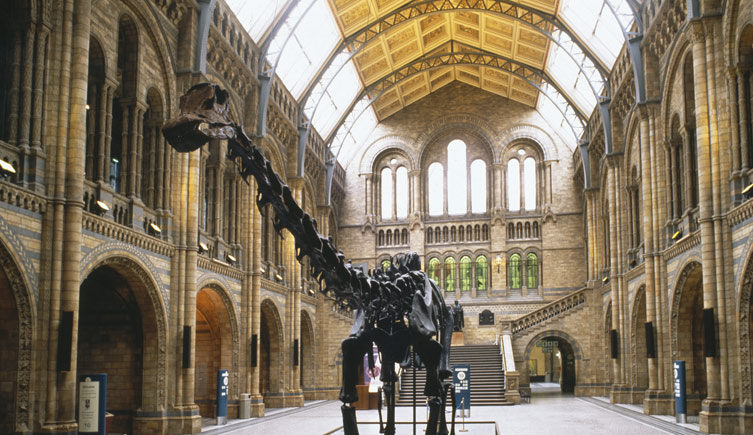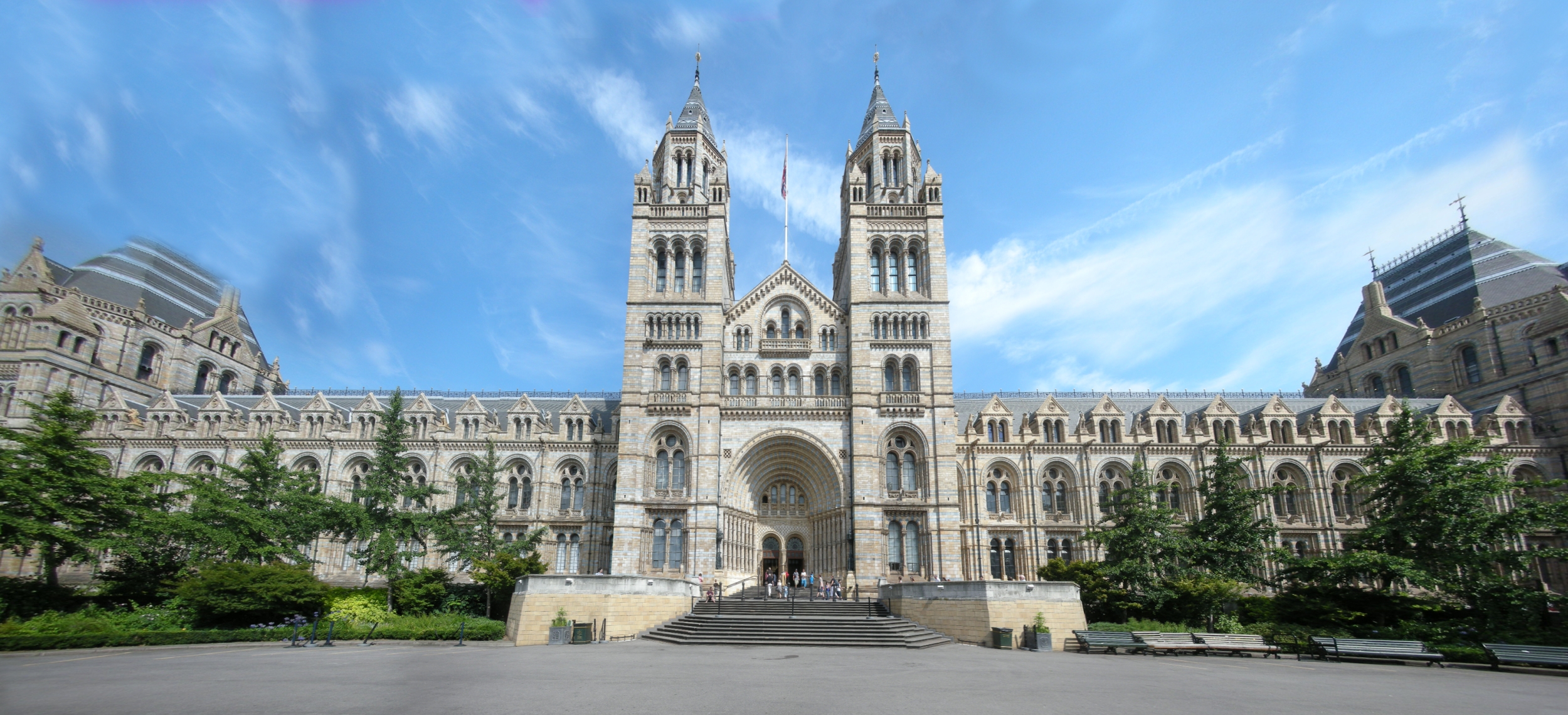Natural History Museum, London
The Natural History Museum ( Naturhistorisches Museum ) in London is one of the largest natural history museums in the world.
It is one of three museums of Exhibition Road in South Kensington. It is housed in a building in the Romanesque- Byzantine style, built in 1860. The museum exhibits together with the Geological Museum, wants to make the connections in nature and clearly show how people depend on the resources of the earth.
Traditionally granted the museum visitors ( except for some special exhibitions) free admission.
Exhibits and attractions
The museum houses about 70 million different objects, including many dinosaur skeletons, fossils ( among them an Archaeopteryx ), exhibits on the flora and fauna, such as the 30 -meter-long skeleton of a blue whale or the model of the extinct Dodo in 1690. Also, here is housed in cooperation with the Geological Museum, the largest collection of meteorites in the world. In the " Earth Galleries " the origin of the earth is shown. One can quite safely experience a simulated volcanic eruption or an earthquake. One of the biggest attractions of the museum is the Tyrannosaurus rex, a robot that behaves lifelike and snaps at visitors and roars.
Life Galleries
In the Life Galleries (exhibitions of life) there are exhibitions of fish, molluscs, crustaceans, amphibians and reptiles, insects, mammals and birds, to fossil marine life, British fossils, exhibits about ecology, evolution, but also minerals and meteorites. The world of plants with their use to humans as well as human biology is given a special value. A simulation represents the perception of a baby in the womb
Earth Galleries
The Earth Galleries ( exhibitions on the ground) in the upper floors can be reached via a staircase that leads through a giant replica of our earth. Shown is the influence of humans on the earth, in order to stimulate a reflection towards a sustainable use. From the Big Bang to the future of the earth a long arc is struck along a timeline. Minerals, ores and rocks will be shown in their forms and displayed in their benefit to man. The forces of nature are explained by the examples of an earthquake and a volcanic eruption and partially simulated. The formation of the Himalayas and the emergence of stalagmites are explained and depicts. The museum also houses one of the world's largest meteorite collections and a newly renovated exhibition meteorites.
Darwin Centre
In the Darwin Centre ( Darwin Centre ) all known species on earth are collected. Already the namesake Charles Darwin created the beginnings of this collection. From him handwritten labels still adorn the first pieces of the collection. A copy of the coelacanth is preserved here. Until now, only the so-called wet collection here. The buildings for the dry collection were opened in the winter of 2008. Scientists grant by appointment a look at the collection.
Wildlife Garden
The garden is adjacent to the West lawn of the museum. The Wildlife Garden offers a quiet zone with thousands of British plants and animals.
History
As the Natural History Museum (Natural History Museum ) was opened on 18 April 1881 Easter Monday, it was a part of the British Museum and was the official term British Museum (Natural History ). Some of the exhibits come from famous 18th century collections. The natural history collection of the famous physicist and oddities collector Sir Hans Sloane forms the basis of the museum. Sloane bequeathed his extensive collection in 1753 of the British nation.
Originally, the original collection of Sloane part of the British Museum (British Museum ), in which even today, especially in the rooms of the exhibition to the Age of Enlightenment in the 18th century ( Enlightenment Galleries ), individual pieces can be seen from Sloane's collection. As the British Museum next to the collection of Sloane couple of other important natural history collections were bequeathed to one thought of its own premises. To mention by name here is the collection that brought the botanist Joseph Banks 1768-1771 from his trip with Captain James Cook on the HMS Endeavour.
The famous zoologist and paleontologist Sir Richard Owen (1804-1892), Head of the natural history department of the British Museum, convinced the government that a new building for the collections had become necessary. He pursued an ambitious plan to show the various species in related groups and exhibit typical representatives with specific characteristics.
The architectural competition was won by the architect Captain Francis Fowke. When he died in 1865, the contract to the young architect Alfred Waterhouse was awarded from Manchester. Waterhouse changed Fowkes design from the Renaissance style of Romanesque Revival ( inspired by the cathedrals of the German Romanesque ) and created the Waterhouse building in its present form. 1883 was the mineralogy and the natural history collections at its present location. Only in 1963 were the collections of the official status as an independent museum. 1988, a connection to the Geological Museum was created and united the two museums.
Research
More than 300 scientists from the NHM (Natural History Museum ) are also now searching still active and take - often associated with international and interdisciplinary projects - in major expeditions. It is about the expansion of the collections, the description and classification of new species, but also to the study of global problems such as environmental pollution, conservation of biodiversity and ecosystems. Also in the field of marine research, the scientists of the museum are active. Became internationally known, among others, Chris Stringer, a leading representative of the so-called out-of -Africa theory for the evolutionary history of modern humans ( Homo sapiens).










